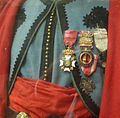The Vatican City State is a neutral nation, which has not engaged in any war since its formation in 1929 by the Lateran Treaty. It has no formal military compact or agreement with neighbouring Italy, although responsibility for defending the Vatican City from an international aggressor is likely to lie primarily with the Italian Armed Forces. When presenting the Lateran Treaty to the Italian parliament in 1929, Benito Mussolini declared: "It is evident that we [the Italian state] will be the necessary guarantors of this neutrality and inviolability [of Vatican City], since, in the remote hypothesis someone wanted to hurt her, he would first have to violate our territory." Although the Vatican City state has never been at war, it was exposed, together with properties of the Holy See in Rome, to bombings during World War II.

The Zouaves were a class of light infantry regiments of the French Army serving between 1830 and 1962 and linked to French North Africa; as well as some units of other countries modelled upon them. The zouaves were among the most decorated units of the French Army.

The Papal States, officially the State of the Church, were a series of territories in the Italian Peninsula under the direct sovereign rule of the pope from 756 until 1870. They were among the major states of Italy from the 8th century until the unification of Italy, between 1859 and 1870.

The Belgian Armed Forces is the national military of Belgium. The King of the Belgians is the commander-in-chief of the Armed Forces. The Belgian Armed Forces was established after Belgium became independent in October 1830. Since then, the Belgian armed forces have fought in World War I, World War II, the Cold War, Kosovo, Rwanda, Somalia and Afghanistan. The Armed Forces comprise five branches: the Land Component, the Air Component, the Naval Component, the Medical Component and the Cyber Component.

Chasseur, a French term for "hunter", is the designation given to certain regiments of French and Belgian light infantry or light cavalry to denote troops trained for rapid action.
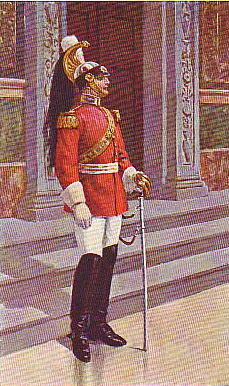
The Noble Guard was one of the household guard units serving the Pope, and formed part of the military in Vatican City. It was formed by Pope Pius VII in 1801 as a regiment of heavy cavalry, and abolished in 1970 by Pope Paul VI following Vatican II. Conceived as the Pope's personal guard, the unit provided a mounted escort for the Pope when he moved about Rome in his carriage and mounted guard outside his apartments in the papal palaces. The guardsmen were also available for special missions within the Papal States at the behest of the pope. One of their first major duties was to escort Pius VII to Paris for the Coronation of Napoleon I in 1804.
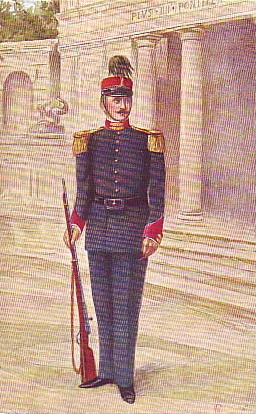
The Palatine Guard was a military unit of the Vatican. It was formed in 1850 by Pope Pius IX, who ordered that the two militia units of the Papal States be amalgamated. The corps was formed as an infantry unit, and took part in watch-keeping in Rome. The only occasion on which it saw active service was during the token resistance on 20 September 1870 to the occupation of Rome by Italian government troops.

John Harrison Surratt Jr. was an American Confederate spy who was accused of plotting with John Wilkes Booth to kidnap U.S. President Abraham Lincoln; he was also suspected of involvement in the Abraham Lincoln assassination. His mother, Mary Surratt, was convicted of conspiracy by a military tribunal and hanged; she owned the boarding house that the conspirators used as a safe house and to plot the scheme.

The Roman question was a dispute regarding the temporal power of the popes as rulers of a civil territory in the context of the Italian Risorgimento. It ended with the Lateran Pacts between King Victor Emmanuel III of Italy and Pope Pius XI in 1929.

The Gendarmerie Corps of Vatican City State is the gendarmerie, or military police and security force, of Vatican City, Holy See and its extraterritorial properties. It was founded in 1816 as Corps of Gendarmes by Pope Pius VII, renamed the Central Security Office in 1970, the Security Corps in 1991, and was restored to its original name in 2002.
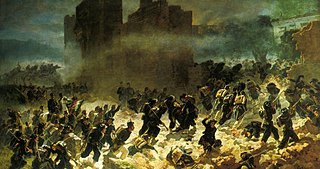
The Capture of Rome on 20 September 1870 was the final event of the unification of Italy (Risorgimento), marking both the final defeat of the Papal States under Pope Pius IX and the unification of most of the Italian Peninsula under the Kingdom of Italy, a constitutional monarchy.

The Corsican Guard was a military unit of the Papal States composed exclusively of Corsican mercenaries on duty in Rome, having the functions of an urban militia and guard for the Pope.

The Battle of Mentana was fought on November 3, 1867, near the village of Mentana, located north-east of Rome, between French-Papal troops and the Italian volunteers led by Giuseppe Garibaldi, who were attempting to capture Rome, then the main centre of the peninsula still outside of the newly unified Kingdom of Italy. The battle ended in a victory by the French-Papal troops.

The Pontifical Swiss Guard is an armed force and honour guard unit maintained by the Holy See that protects the Pope and the Apostolic Palace within the territory of the Vatican City State. Established in 1506 under Pope Julius II, the Pontifical Swiss Guard is among the oldest military units in continuous operation.
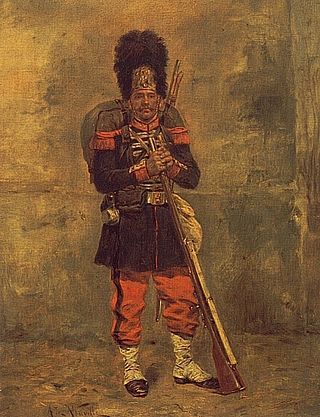
The Imperial Guard of Napoleon III was a military corps in the French Army formed by Napoleon III as a re-establishment of his uncle Napoleon I's Imperial Guard, with an updated version of the original uniforms and almost the same privileges.
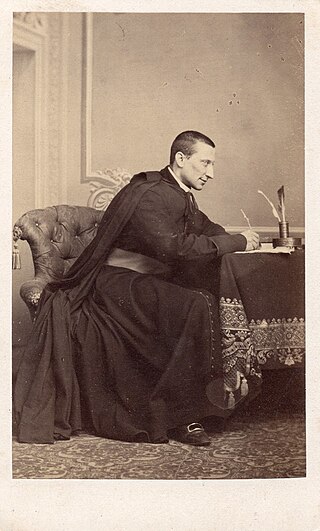
Xavier de Mérode was a Belgian prelate, archbishop and statesman of the Papal states.
The Legion of Antibes, also known as the Roman Legion was a formation of the Papal Army created on 8 September 1866 consisting of French Volunteers.

François Rochebrune was a French soldier who served in the French Zouaves during the Crimean War. He then lived in Poland for two years as a tutor. He returned to the French Zouaves for five years, serving as a sergeant in China. He then returned to live in Poland once again in 1862. When the Polish rebellion against Russian rule began in January 1863, he formed and led a Polish rebel unit called the Zouaves of Death. Within months, he had been promoted to general. After the collapse of the uprising, he returned to France, where his exploits in Poland earned him the rank of captain in the French army. He was promoted to colonel for the Franco-Prussian War, and was killed by a sniper at the Battle of Montretout at the age of forty.
The Guards Rifles Battalion was an infantry unit of the Prussian Army. Together with the Guards Ranger Battalion it formed the light infantry within the 3rd Guards Infantry Brigade in the 2nd Guards Division of the Guards Corps. The battalion consisted of four companies.

Belgium was not a belligerent in the Franco-Prussian War (1870–1871), as the country was neutral throughout the war, but was heavily influenced by the social and political effects of the conflict. An invasion of Belgian territory by either side was widely feared in 1870 and the Belgian Army was mobilised. The inadequacies which this revealed in Belgium's military and defensive preparations led to calls to reform the system of conscription and for a programme of fortification-building which would greatly influence the early phases of World War I.


